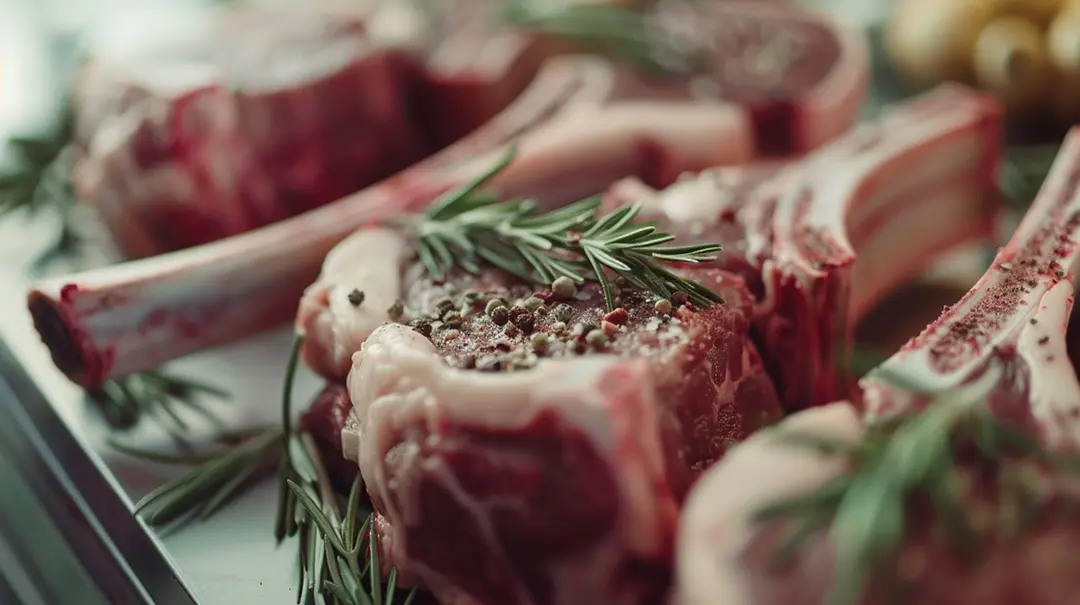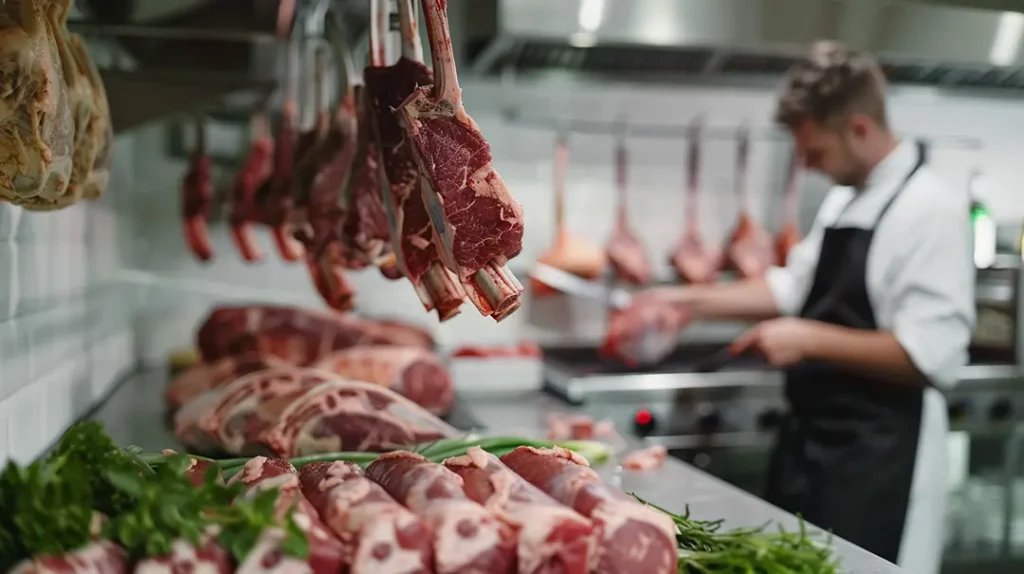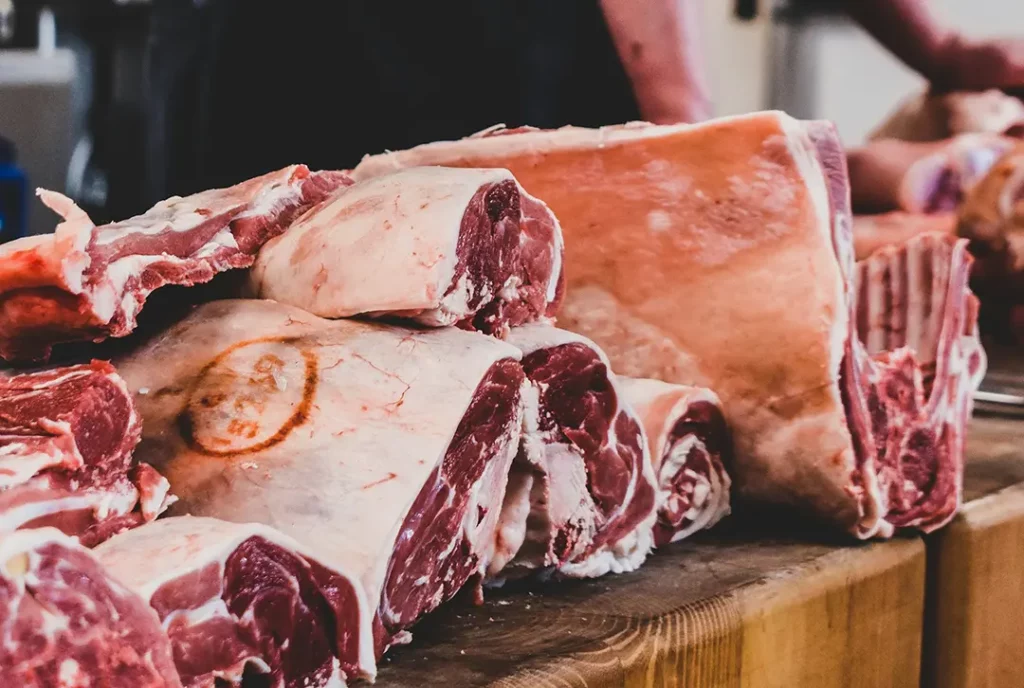
Understanding the differences between lamb, hogget, and mutton enhances your cooking experience. Lamb is mild and tender, ideal for various dishes, while hogget offers a richer flavour and firmer texture, perfect for hearty meals. Mutton, with its intense taste and aroma, is best for slow-cooking to tenderise the meat and balance its robust flavours.
Sheep meat, categorised as lamb, hogget, or mutton, differs significantly in flavour, texture, and aroma depending on the age of the animal. Recognising these distinctions enhances the cooking and dining experience. Additionally, understanding legislative differences between the UK and EU, as well as considerations around imported meat, is crucial for informed consumer choices.
The primary differences in sheep meat are age-related, affecting flavour, texture, and aroma. Lamb offers a mild taste and tender texture with a subtle aroma, suitable for various cooking methods. Hogget provides a more robust flavour and aroma with a slightly firmer texture, ideal for substantial dishes. Mutton, being the oldest, has the most intense taste and aroma, best suited for slow-cooking to tenderise the meat and balance its rich flavour.

Lamb, from sheep less than one year old, is known for its mild, slightly sweet aroma. This subtle scent is not overpowering, making lamb versatile for various dishes. Visually, lamb meat is light pink with a fine grain and a smooth, creamy fat layer, indicative of its youthful tenderness. Ideal for dishes that benefit from delicate flavours, lamb is best prepared through methods like grilling or roasting, such as in lamb chops or a roasted leg.
Hogget is sourced from sheep aged between one and two years, offering a more pronounced aroma compared to lamb. Its richer, somewhat earthy scent reflects a deeper flavour profile. Hogget meat is darker red, has a coarser texture, and features a more noticeable fat layer. This type of meat is well-suited for hearty, slow-cooked dishes or roasts, where its full flavour can be appreciated.
Mutton comes from sheep over two years old and has the strongest aroma among the three types, emitting a robust, gamey scent. The meat is deep red to brownish, with a firm texture and a thick, yellowish fat layer. Mutton’s intense flavour and aroma make it ideal for slow-cooking methods such as stewing or braising, which help tenderise the meat and harmonise its strong flavours.
When selecting sheep meat, it is useful to rely on both visual and olfactory cues:
Lamb: Mild, sweet aroma with light pink meat, fine grain, and creamy fat.
Hogget: Richer, earthy scent, darker red meat, coarser texture, and more noticeable fat.
Mutton: Strong, gamey aroma, deep red to brownish meat, firm texture, and thick, yellowish fat.
These sensory characteristics, alongside flavour and texture, help determine the best type of meat for your culinary needs.

Choosing the right type of sheep meat depends on the recipe and desired flavour profile. Lamb is widely available, whereas hogget and mutton may require sourcing from a speciality butcher. Recognising the aroma and texture of the meat can be crucial in selecting the right product for your culinary goals.
In many European supermarkets, you’ll often find all sheep meat labelled as “lamb,” even if it technically comes from older animals. This practice simplifies shopping and aligns with consumer preferences, as most people associate lamb with tenderness and mild flavour. The European Union’s guidelines on labelling sheep meat are not as strict, allowing individual countries to decide how to label their products. This flexibility means that even meat from older sheep might still be sold as lamb.
UK regulations mandate that meat labels clearly indicate whether the product is lamb, hogget, or mutton, along with its country of origin. This transparency helps consumers make informed decisions about quality and provenance.
In the EU, labelling requirements are also stringent but may vary slightly in categorising the meat and detailing its origin. EU regulations as a whole often focus more on animal welfare and environmental impact, influencing production methods and potentially affecting consumer preferences.
In 2015, the European Union decided to change how sheep meat is labeled. They wanted to make sure people knew more about the meat they were buying. This new system supposedly helps shoppers understand where their food comes from.
Now, when you look at a package of sheep meat in an EU country, you should see some important information. The label tells you two main things: where the sheep lived and where it was processed. For example, you might see “Raised in France” and “Slaughtered in Spain” on the package.
The EU made these rules for a few reasons. First, they wanted to stop any confusion about where meat comes from. Sometimes, packaging can make you think meat is from one place when it’s really from another. These new labels make sure that doesn’t happen.
The rules cover most types of sheep meat you’d find in a store. They also apply to meat used in restaurants. However, they don’t cover processed meat products, which have their own set of rules.
One important part of this system is that it works behind the scenes too. The EU requires a way to track meat from the farm all the way to the store. This helps make sure the information on the label is correct.
These guidelines are all about giving people more information. The EU believes that when you know where your meat comes from, you can make better choices about what you buy and eat. It’s part of a bigger plan to make the food industry more open and honest.
In some European regions, especially in the south, the focus is more on how the meat is prepared rather than the specific type of sheep it comes from. This cultural approach means that dishes may be labelled simply as “lamb,” even if they are made with hogget or mutton. However, traditional terms like “hogget” and “mutton” haven’t disappeared entirely. In northern England and Scotland, for example, these terms are still commonly used, preserving local culinary traditions.
In the Mediterranean region, different countries have their own unique names and cultural practices for lamb, hogget, and mutton. Here’s a look at some of these regional names and distinctions:
These regional names reflect the rich culinary traditions of the Mediterranean, where the age and type of sheep meat play a significant role in the flavor and preparation of dishes. Each country has its own preferences and specialties, showcasing the diversity of sheep meat cuisine across the region.

A significant portion of sheep meat in the UK and EU markets is imported, mainly from New Zealand and Australia. New Zealand is renowned for its high-quality lamb, known for consistent flavour and texture. Similarly, Australian lamb is well-regarded, though it may have slight flavour variations due to different farming practices and feed.
In New Zealand, recent changes in labelling regulations allow meat from older sheep to be called lamb. As a result, when this meat is imported to Europe, it often retains the “lamb” label, regardless of whether it might be classified as hogget or mutton under different standards.
New Zealand follows stringent standards for Halal meat, overseen by organisations like the Federation of Islamic Associations of New Zealand (FIANZ). Although exact percentages are not specified, around 43% of New Zealand’s total red meat exports, including both beef and lamb, are Halal-certified. There are claims that up to 70% of New Zealand lamb sold in the UK is Halal, though this figure lacks definitive verification.
Experimenting with lamb, hogget, and mutton can open up a variety of flavours and aromas, enriching your cooking repertoire. Each type of meat offers unique qualities that are well-suited to specific dishes. Understanding the best preparation methods for each can enhance your culinary creations.
Mediterranean Lamb Bowls: A versatile dish featuring ground lamb seasoned with Mediterranean spices, served over turmeric rice with fresh vegetables, hummus, and feta cheese.
Grilled Lamb Chops: Marinated in Mediterranean herbs and spices, then grilled to perfection. Often served with a tomato-mint quinoa.
Roast Rack of Lamb: Prepared with a garlic and herb crust, this dish is a Mediterranean favourite for special occasions.
Kleftiko (Greek Lamb in Parchment): A traditional Greek dish of slow-roasted lamb cooked in parchment paper with potatoes and vegetables.
Mediterranean-Style Roasted Leg of Lamb: Seasoned with herbs like rosemary and thyme, and often served with roasted vegetables.
Slow Roast Hogget with Lemon & Thyme: A dish that showcases the rich flavour of hogget, seasoned with Mediterranean herbs and slow-roasted for tenderness.
Roast Hogget: Similar to roast lamb but with a more developed flavour, often prepared with Mediterranean herbs and served with roasted vegetables.
Grilled Hogget Chops: Seasoned with Mediterranean spices and herbs, then grilled for a flavourful main course.
Youvetsi: A Greek stew made with mutton or lamb and orzo pasta, seasoned with tomatoes and spices.
Moroccan Mutton Tagine: A slow-cooked stew with mutton, vegetables, and aromatic spices, often served over couscous.
Lebanese Stuffed Grape Leaves with Mutton: A traditional dish where grape leaves are stuffed with seasoned mutton and rice, then simmered in a flavourful broth.
Algerian Mutton Shoulder Stew: A hearty stew made with mutton shoulder, vegetables, and Mediterranean spices, often served with couscous.
While lamb is widely used in Mediterranean cuisine, specific hogget and mutton dishes are less common in modern Mediterranean cooking. Hogget and mutton are more prevalent in traditional recipes, especially in rural areas or in dishes that benefit from the stronger flavour of older sheep. Many dishes traditionally made with mutton are now often prepared with lamb in contemporary Mediterranean cooking.
When navigating the world of sheep meat, forming a good relationship with your butcher can be invaluable. Butchers are often very knowledgeable and more than willing to answer any questions you might have, whether you’re curious about the differences between lamb, hogget, and mutton or need advice on the best cooking methods for a particular cut. Don’t hesitate to ask for recommendations based on your taste preferences and recipe needs. Your local butcher can also provide insights into the origins of the meat, ensuring that you make informed choices. Building a rapport with your butcher not only enhances your shopping experience but also helps you explore new culinary possibilities with confidence.
For those interested in exploring further, a range of recipes tailored to the distinct characteristics of lamb, hogget, and mutton is available. Speciality butchers can provide advice on sourcing and preparing these meats to achieve the best results. Whether you are a seasoned chef or a culinary enthusiast, these resources can guide you in creating delicious meals that highlight the unique flavours and aromas of each type of sheep meat.

At Med.kitchen, our passion lies in crafting exceptional culinary experiences through our online platform. We specialise in sharing a wealth of knowledge via articles, recipes, courses, and online mentoring, aiming to inspire both novice and seasoned chefs alike. Our focus has shifted from private dining to being an online source of gastronomic inspiration, allowing you to explore and refine your culinary skills from the comfort of your home..